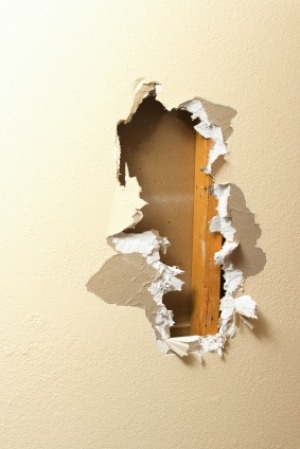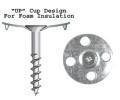 My boyfriend and I just bought a house a little over a year ago and I just realized today that in the guest bedroom the paint is bubbling. The wall is soft to the touch around it. What do I need to do to fix this?
My boyfriend and I just bought a house a little over a year ago and I just realized today that in the guest bedroom the paint is bubbling. The wall is soft to the touch around it. What do I need to do to fix this?
By Cassie from Kansas City, MO
This sounds like a water problem. It could be leaking at a window or door, or could be a roof problem with water running inside the wall. This is a perfect breeding ground for mold and termites. First you must find and fix the source of the leak, then you must remove the drywall so you can check out the wood structure, replacing any rotted wood and removing any mold. If you can't handle the job yourself, my advice is to call in a professional. This is a problem that must be fixed before it gets worse. Good luck.
It sounds to me like it could possibly be termites. If you see on the floor what looks like sand around the base boards then you need to check it out.
I agree that it sounds like a water leak somewhere. Around the chimney flashing if a good place to check. Loose shingles? Better check it out really well, before u get bugs, mold etc.
I am also thinking water leak. Is this bedroom next to a bathroom? You could be getting leaks through the wall from the shower enclosure. The most common reason for drywall to go soft is because it has absorbed water from someplace.
To fix this, you need to find the source of the water leak, and get that stopped. Then, you deal with this wall. The drywall will have to be removed, and maybe even the studs in the wall, if they are rotten. Wood takes time to rot, however, and it may just need to be dried out. There may be mold in the wall, and that will need to be removed. I see them doing it with steam cleaners on TV, but I would call in a professional for this sort of job.
I noticed after I moved in there was a small area on the wall bubbling and soft to the touched
Here are the questions asked by community members. Read on to see the answers provided by the ThriftyFun community.
I just brought a house and added a shower to my bathroom. The ceiling above my shower is now cracking and peeling slowly due to the moisture from the steam. I have a sky light in my bathroom but the previous owners had a hard plastic, light brown material covering the ceiling to prevent cold air or the stop so much sun from coming down in the bathroom from the sky light.
Do I need to remove that plastic material or install a ceiling fan to stop the ceiling from peeling? My bathroom looked nice when it was first done but now it looks bad.
Michelle from Baltimore, MD
Yes, a fan would help. One solution I would consider is to remove the ceiling where you are having the problem, apply a sheet of what is called blue board. It is a water proof product used in place of sheet rock around showers and tubs. Tape and compound the joint. Apply skim coat of plaster and paint with a ceiling paint.
I suggest that you put in an exhaust fan but go bigger than the recommendations. I too have this problem and was told to use a much bigger fan than what is recommended for the size of the bathroom.
Karyn
Adding a Fan is Great Advise.The First Question though is Why is the paint Peeling in the first place.For Example Is there a window in the bathroom?what sheen is on the ceiling? if it is semi-Gloss it will need to be sanded down..Using a stain blocking primer after that will help seal the drywall.There is no need to use primer over the Stain block .Next when ever painting in a kitchen or shower area you must use Kitchen and bath paint.Reason being it has mildesides in it to prevent Mildew.
(Submitted via email)
Hi, first are you sure you don't have a roof leak/ Make sure there is not water behind the drywall on the ceiling if there is not..Then use stain block primer and a Kitchen and bath paint over that. Thomas
After removing wood paneling that had been glued on over an unfinished drywall, I noticed that the drywall paper had been torn away in several spots. The exposed gypsum is smooth and intact. Can I tape over these areas or should the drywall be replaced?
By Chris Marvin from Felton, CA
Here's an answer from my carpenter of 20 years husband: "If you are going to paint it, you could tape over it, but if it's no big deal, I'd replace it, because you'll get a smoother finish."
You can spatula on a thin layer of drywall mud and then once completely dry lightly sand with fine sand paper wrapped around a wood block to even out. There will be mud dust doing this but all you have to do is cover up furniture, etc. and be sure to have the doors closed to other rooms. I've done this a couple of times in doing such minor drywall repairs and it works well. If you use drywall tape you're going to have to mud anyway (and actually have to use more mud) so why not save a step?
P.S. Always wear a doctor's type mask when sanding so the dust doesn't get in your lungs.
We live in an old house. The bathroom off our bedroom was once a small porch and the former owners made a small bathroom out of it. However, it has no air conditioning or heat. It's just built on a cement slab.
By metroplex from Houston, TX, USA
Since it's a room that receives a lot of moisture I would use the heavier, thick paste type of Spackle rather than the whipped fluffy kind you can use for picture holes and minor cracks. Even if you have to do two or three coats; do it that way (multiple coats) because globbing on a lot of the thick Spackle in one go doesn't work very well because that will crack upon complete drying. If you have to do more than one coat be sure to lightly sand between each coat.
I would use the webbed seam tape for wallboard as well on the cracks. This will help it from cracking again. Apply the webbed tape and use a putty knife to put the spackle ( I use wallboard paste) over the tape in a thin layer and let this layer dry. Then put another layer on covering any signs of the tape. Let dry completely and sand the area with sanding grid to make a smooth look. Prime with white flat paint then put your paint of choice on. It takes time to do this but the end results will look nice. My husband was a handyman and I was a handywoman and did all his wallboard repairs for him. If you have water stains use the shelac based Kilz.
You live in a humid climate, the problems will only continue. Figure out a way to vent that place before the problems multiply! Congrats on fixing up the place! Buy the best venting you can afford. We purchased a vent for our no-window bathroom and although the clerk told us we did not need a higher HP motor, he was so wrong!
Does anyone know what the best way to repair dry wall after removing paneling in a kitchen. It goes half way up the wall and there is wallpaper on top. I wanted to remove all of that and smooth the walls to paint.
Assuming the drywall is in one piece with no breakage, these are the steps I suggest (been there done that!) I'm no pro but working alongside my husband when remodeling and adding on to our home, this is how we prepped drywall for painting. We used spackling compound, which is like plaster- (either premixed or dry, but we usually mixed our own so it wouldn't go to waste). With a putty knife or scraper, fill in the nail holes. If there are large areas to repair, I would suggest using a "mesh" screen specifically made for larger repairs so as to give the plastered area more support and prevent cracking later on. This is put over the spackled area, then a thin layer of spackling compound is applied over the screen. Always try to fill in enough and then some so it will be level with no dips when finished. Then remove excess with the putty knife or scraper, feathering the edges outward to smooth somewhat. Let dry overnight at least. We always waited 24 hours before sanding to a smooth finish. The dust from sanding can be removed from wall using a SLIGHTLY dampened rag. When completely dust free and dry, it's time to prime the drywall with a paint primer before painting the final color. Hope this helps. It does create a lot of dust, so be sure to cover furniture and store food tightly for protection. Good luck!
This is what my girlfriend and her husband, who are drywall finishers recommend.
Depending upon the size of the area, go to your local hardware store or similar store, purchase some dry wall mud and a large putty knife. If needed, mix the mud with water according to directions. Put enough mud on the knife to smooth across it leaving a good foundation. Scrape the knife extra back into your mud "bucket". Take the knife over it again going through the center first, then the outer edges using equal pressure. Allow it to dry at least 12 hours. Reapply if needed and wait another 12 hours. Then sand it using fine sandpaper. They also recommend using a shop vac or vacuum to collect the dust and a soft brush attachment to go over the wall to make sure you have gotten all of the dust. Any kind of moisture on a rag is not advisable, as that adds moisture back into the mud.
Hope this helps.
Janet in Georgia
When we removed the panelling from our living room, we had no choice but to put up all new sheetrock. The panelling was apparently glued to the walls and when we pulled it of it ripped the sheet rock pretty badly.
In my bedroom, the metal strip between the wall and ceiling has separated leaving a long running crack. My husband says the whole strip has to come off to fix that corner, but then that means I have to sacrifice my wallpaper. Is there anyway to reattach (glue?) the back of the strip, and then apply joint compound and then sand? Thank you. I can't imagine having to remove an entire room full of wallpaper I still like.
By Kelly
Glue wont hold it. You will need to use joint compound.
You need joint compound and the drywall tape.
I have one bedroom wall that has something with a white facing paper and a smooth backing of tan-ish brown that is also brittle and thin. There are also visible seams like drywall boards or poorly hung wallpaper. Beneath this a textured concrete wall. The other three walls have a small curd bumpy texture.
In the living room we also have the same wall textures; one being trowel, with a brick fireplace, the other three being small bumps. I removed two layers of printed wall paper from the troweled wall in the living room and painted over that with several coats of a latex semigloss paint with good results; the other three walls were painted in a contrasting color.
So, given the similarities, how do I tell the difference between drywall paper and wallpaper backings? Please help!
By T.R from C, NC
Hi T.R,
It sounds like wallpaper to me. Because the paper covering drywall is typically not thin or brittle. It has some depth, strength and layer to it. When you remove it is the chalky white filler that crumbles used in drywall there? Usually when you strip old wallpaper it has a hue between a dingy darker yellow to a coffee stain color on the back. Depending on how old it is it may or may not still have some of the paste feel to it-kinda slimy when wet.
It could have been painted over. I came across that in the last house I bought. When I went to paint I realized they had multiple layers of paint over layers of wallpaper. Frustrating, it took a good two weeks to complete one room. After that I gave up and added another layer of paint just like they did.
Hope this helps. Kathei
Thank you so much Kathei! I went and checked after reading your answer and what I saw was what looked like blotches of white on the wall proper that came off on my finger when I rubbed it but didn't flake. It almost looks as though there might have been drywall at one time. It's the only thing I can think of that would leave splotches like that. Like you, my first thought was old wallpaper, though I was able to peel some of the backing away, it was very thin w/o body and I didn't see any sign of print on what I had. After doing some reading, I learned that drywall backing is fuzzy, like a brown paper bag might be when torn, and needs to be sanded down before doing anything. There is nothing fuzzy here! Also the seems are placed about two and a half feet apart like wallpaper would be. I have no idea about the width(s) of drywall.The backing of this is a coffee stain color with a slight sticky feel when moistened. Beneath this (and the white splotches), is a gray concrete. Now I am wondering if I need to do something about these splotches before I do any painting; I don't want the paint or primer coming of with the stuff that rubs off.any ideas or suggestions from you or anyone else would be appreciated. Thank you again Kathei.-T.R
My basement sheet-rock ceiling seam bulges, about 3" wide and 6 ft. long (from a water leak). How can I get ride of this slight bulge (1/16") as I paint the ceiling?
Thanks,
Susan from Washington, DC
im sorry to tell you this but there are 2 options one is spackel the whole ceiling to hide it or cut the part out that buldges and replace with new drywall. you will need help because it is over your head.
Try plaster washers (McFeeleys.com) if the drywall is dry and not damaged from the water. You screw these into the drywall at the studs and it will pull the drywall up.

Can I mix Elmer's glue with drywall compound for a stronger patch?
By Sandy
Go to Elmer's website for info:
elmers.com/
I removed wallpaper from the wall. The wall is now partially rough as the top layer of sheet rock came off with wallpaper. How can the wall be repaired?
By Heyjudecf
Easy fix here. Use a product called Gardz from Zinsser. It is a clear bonding primer. Basically you use it to seal down the drywall paper, then you patch the wall where you have to, then you put one more coat of Gardz on to seal the compound. Then you can paint over it.
I have an area right next to the shower tile on the drywall that is very damaged and wet with mold and mildew. Can this spread behind the shower tile wall? And what can I do to remedy this problem? Thanks for any help.
By Linda

Get a carpenter that can do the job, good luck.
I need some tips on how to fix a crack in dry wall.
Thanks,
Oliver Parker
This is a page about repairing drywall after wallpaper removal. After removing wallpaper, the walls will need cleaning and perhaps some repair, prior to painting or whatever your next wall treatment will be.